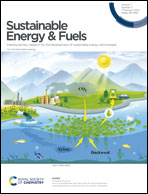Efficient carrier transfer induced by Au nanoparticles for photoelectrochemical nitrogen reduction†
Abstract
The photoelectrochemical nitrogen reduction reaction (PEC-NRR) driven by solar energy is a low-energy consumption and pollution-free ammonia synthesis method, which is expected to overtake the traditional Haber–Bosch process. Recently, abundant catalysts have been scouted for the PEC-NRR, while the poor understanding of the PEC-NRR mechanism limits the design of efficient catalytic systems and is detrimental to the industrial application. The size effect of metals is one of the most important factors affecting the activity of metal-supported catalysts, but there is still a lack of relevant research in the PEC-NRR. Herein, we developed gold nanoparticle (Au NP) supported titanium dioxide (TiO2) as an efficient photocathode for the PEC-NRR, and the size effect of Au NPs was designed and investigated for clarifying the active structure and reaction mechanism of Au NPs on TiO2. The smallest Au NP catalyst (Au3.0–TiO2) showed the best NH3 yield of 1.5 μg h−1 cm−2, which is 7.5 times higher than that of TiO2. The optimal electron transfer and larger active surface area in Au3.0–TiO2 were revealed, and density functional theory (DFT) calculations confirmed that Au NPs can reduce the reaction energy barrier and the smaller Au NPs have better selectivity for the NRR and inhibition of the competing HER. The study herein could provide guidelines for the development of efficient metal-supported catalysts for the PEC-NRR.



 Please wait while we load your content...
Please wait while we load your content...